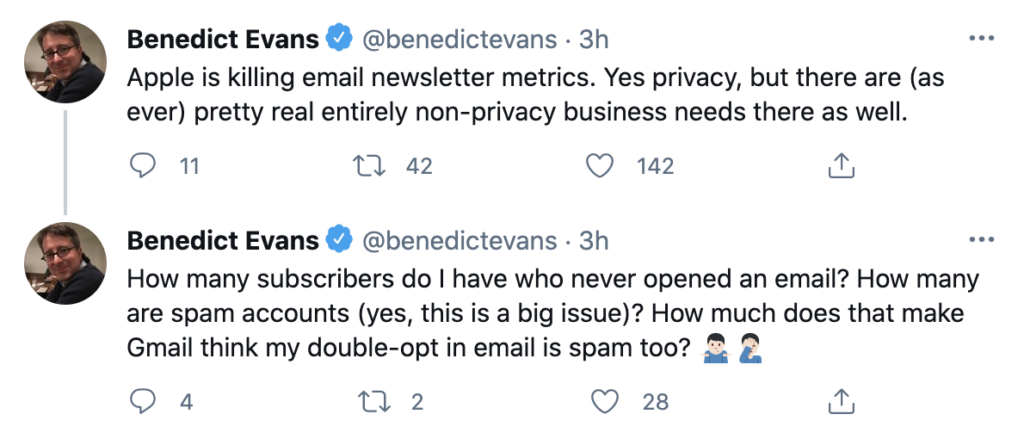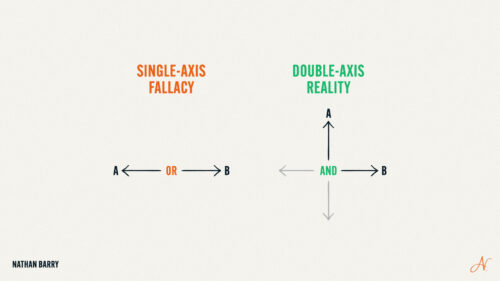Today Apple announced sweeping new privacy protections across iOS15 and macOS Monterey. Many of these are great changes that give consumers more control of their privacy. It’s creepy that visiting a website on one device changes your entire browsing experience on your other devices, so Apple’s announcement of Private Relay and other tools are an exciting change for privacy.
Even as the CEO of an email marketing platform for creators, I’m excited about features like Hide My Email that give consumers even more control over their identity with one time use email addresses.
But included in that update is one feature that actively hurts creators: Mail Privacy Protection. From Apple’s press release:
“The new feature helps users prevent senders from knowing when they open an email, and masks their IP address so it can’t be linked to other online activity or used to determine their location.”
While touring musicians and others hosting location based events will miss the location data, there are other ways to ask fans for that information. The real problem is in blocking all open tracking. Here’s why:
Mailbox providers like Apple put the burden on creators to only send to engaged subscribers
Creators often debate if they should clean subscribers off their email lists who are no longer engaged. We know from running an email provider that sends over 1 billion emails per month, the data is very clear: to maintain great inbox placement you must clean inactive subscribers.
Apple even directly recommends it on their postmaster page.
Unfortunately mailbox providers like Apple, Gmail, and others don’t provide any tools to do this. So creators use open tracking pixels to approximate engaged subscribers.
The penalties for not cleaning your list are severe
Many creators might not know that some email addresses are spam traps and that emailing them could cause major deliverability issues.
A spam trap is an email address that doesn’t belong to a real person, but is instead used by spam filters and blocklist providers to find senders who aren’t following best practices. It’s common for spam traps to make it onto well-meaning creators’ lists through bad email signups or email addresses that were once valid, but have since become “recycled”. An example of a recycled spam trap is an email address you used 5 years ago, but abandoned. That email address could be turned into a recycled spam trap without your knowledge.
Along with making sure all of your subscribers have given consent to receive your emails, the key to avoiding spam traps is regularly cleaning out subscribers who aren’t opening your emails.
Apple is removing creators’ primary tool for maintaining a clean list
Without open rate data, keeping spam traps off your list will become very difficult. If senders email a large number of spam traps or a spam trap that belongs to a serious blocklist, it can cause messages to go to the spam folder or be rejected completely.
This change puts creators at an unfair disadvantage to get their work in front of their biggest fans. Inbox providers like Apple ask that senders keep their list clean and engaged, but then take away the metrics senders need to actually do that.
If creators rely on click tracking—the only remaining method of determining engagement—to clean their lists they’ll remove a lot of engaged subscribers who simply consume the emails without clicking through to the web.
Creators will have to choose between taking extreme list cleaning measures where healthy, engaged subscribers get removed because they aren’t clicking emails, or they won’t do any list cleaning which will likely lead to spam filtering for both engaged and unengaged subscribers.

There’s a privacy focused alternative
Apple could have blocked open pixels while also giving senders a solution for keeping their list clean and sender reputation healthy. For example, spam complaint feedback loops are a necessity in the email industry. When a subscriber marks a message as spam, the mailbox provider (like Apple) reports back to the sender that the message was marked as spam.
Apple could implement a similar feedback loop to let senders know that a subscriber has become unengaged. Apple is still going to be tracking whether or not subscribers are opening emails in order to determine if emails belong in the inbox or spam folder. Instead of keeping all of this information to themselves, they could find solutions that cater to privacy-focused subscribers and help email senders be responsible with their list health.
Litmus reports that Apple holds 58% of the email client market share, so this change will make it harder for all creators who are making great content to follow industry best practices.
While we’re excited for more privacy controls to be in the hands of consumers, we hope that Apple and other inbox providers will make better tools for compliance to replace the tools they are removing.
Thanks to Alyssa Dulin, our deliverability lead at ConvertKit, for co-writing this article. To keep learning about deliverability, inbox placement, and email best practices subscribe to her podcast, Deliverability Defined.



Loved it, Alyssa
The new apple approach maybe impacts the industry for a short period of time but the problem is the root of innovation.
We (Creators) will develop a way to conquer this issue. By the way, I also agree with your practical solution.
Very well-explained. Thanks. Do you know if we can segment our emails by Apple mail addresses? Before I scrub my list again, I think I would like to exclude the Apple clients.
I agree with Apple take in this, I already block all images in my email client for this exact same reason. One thing is list higiene which I support, but many services use that information for other purposes and it’s creeping tha someone knows when and where you read your emails. It’s like if someone sending you a paper mail then sneaks behind the window to check when you read it… I’m sorry, but marketing tools will have to find a different way than to invade privacy